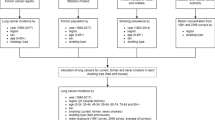Abstract
Purpose
Lung cancer is the leading cause of U.S. cancer deaths and radon is the second leading risk factor for lung cancer. By better understanding geologic variations of radon production in states, comprehensive cancer control efforts could be improved. The study purpose was to assess states with the greatest potential for elevated radon and the likelihood of radon-related actions in National Comprehensive Cancer Control Program (NCCCP) awardee cancer plans.
Methods
Two state-level variables were derived to approximate potential for elevated radon using the Environmental Protection Agency county map and the 2015 U.S. Census. The association between radon potential and inclusion of radon activity within cancer plans was evaluated using logistic regression.
Results
Fifty-one percent of cancer plans recognized an association between radon and cancer risk, and included measurable radon activities. Most states with high radon potential included radon activity in cancer plans. Both measures of radon potential were significantly associated with NCCCP cancer plans including radon activity.
Conclusions
Geospatial analyses help to prioritize radon-related lung cancer activities. In areas with high potential for radon exposure, increasing knowledge about potential for radon exposure may result in increased radon testing, mitigation, or other radon reducing strategies, and ultimately reduction of lung cancer deaths.

Similar content being viewed by others
References
U.S. Cancer Statistics Working Group (2017) United States cancer statistics: 1999–2014 incidence and mortality web-based report. U.S. Department of Health and Human Services, Centers for Disease Control and Prevention and National Cancer Institute, Atlanta
Leffalle L, Kripke M (2010) 2008–2009 president’s cancer panel: reducing environmental cancer risk. In: What we can do now. U.S. Department of Health and Human Services, National Institutes of Health, National Cancer Institute, Washington, DC
National Research Council (1999) Health effects of exposure to radon: BEIR VI. National Research Council Commission on Life Sciences, Washington, DC
Samet JM, Avila-Tang E, Boffetta P, Hannan LM, Olivo-Marston S, Thun MJ et al (2009) Lung cancer in never smokers: clinical epidemiology and environmental risk factors. Clin Cancer Res 15(18):5626–5645. https://doi.org/10.1158/1078-0432.ccr-09-0376
Darby S, Hill D, Auvinen A, Barrios-Dios JM, Baysson H, Bochicchio F et al (2005) Radon in homes and risk of lung cancer: collaborative analysis of individual data from 13 European case-control studies. BMJ 330(7485):223–226. https://doi.org/10.1136/bmj.38308.477650.63
Krewski D, Lubin JH, Zielinski JM, Alavanja M, Catalan VS, Field RW et al (2005) Residential radon and risk of lung cancer—a combined analysis of 7 north American case-control studies. Epidemiology 16(2):137–145. https://doi.org/10.1097/01.ede.0000152522.80261.e3
Lubin JH, Wang ZY, Boice JD Jr, Xu ZY, Blot WJ, De Wang L et al (2004) Risk of lung cancer and residential radon in China: pooled results of two studies. Int J Cancer 109(1):132–137. https://doi.org/10.1002/ijc.11683
U.S. Environmental Protection Agency. EPA assessment of risks from radon in homes (2003) http://www.epa.gov/radon/pdfs/402-r-03-003.pdf. Accessed 21 June 2018
U.S. Environmental Protection Agency (2016) Consumer’s guide to radon reduction. U.S. Environmental Protection Agency, Washington, D.C.
U.S. Department of Health and Human Services (2009) The surgeon general’s call to action to promote health homes. In: U.S. Department of Health and Human Services OotSG, editor. Rockville
Division of Cancer Prevention and Control Centers for Disease Control and Prevention. National Comprehensive Cancer Control Program (NCCCP) (2017) https://www.cdc.gov/cancer/ncccp/. Accessed 3rd April 2017
Acree P, Puckett M, Neri A (2017) Evaluating progress in radon control activities for lung cancer prevention in national comprehensive cancer control program plans, 2011–2015. Journal of community health 42(5):962–967. https://doi.org/10.1007/s10900-017-0342-7
Neri A, Stewart SL, Angell W (2013) Radon control activities for lung cancer prevention in national comprehensive cancer control program plans, 2005–2011. Prev Chronic Dis 10:E132. https://doi.org/10.5888/pcd10.120337
U.S. Environmental Protection Agency. EPA Map of Radon Zones (1993) https://www.epa.gov/radon/epa-map-radon-zones. Accessed 20 March 2018
U.S. Census Bureau. American Community Survey, 2015 American Community Survey 1-Year Estimates generated using American FactFinder (2015) http://factfinder2.census.gov. Accessed 28 March 2017
U.S. Cancer Statistics Working Group (2017) United States cancer statistics: 1999–2014 incidence and mortality web-based report. Atlanta, GA. http://www.cdc.gov/uscs
U.S. Cancer Statistics Working Group (2017) U.S. Cancer Statistics Publication Criteria. Atlanta
Centers for Disease Control and Prevention (2015) BRFSS Survey Data and Documentation. 2017. https://www.cdc.gov/brfss/annual_data/annual_2015.html. Accessed 19 April 2018
Neri A, McNaughton C, Momin B, Puckett M, Gallaway MS (2018) Measuring public knowledge, attitudes, and behaviors related to radon to inform cancer control activities and practices. Indoor Air 28(4):604–610. https://doi.org/10.1111/ina.12468
U.S. Environmental Protection Agency. The National Radon Action Plan - A Strategy for Saving Lives. Washington DC (2015) http://www.epa.gov/radon/national-radon-action-plan-strategysaving-lives Accessed 21 May 2018
Centers for Disease Control and Prevention. Cancer Prevention and Control Programs for State, Territorial, and Tribal Organizations (CDC-RFA-DP17-1701, CFDA 93.898) (2017) https://www.grants.gov/web/grants/search-grants.html. Accessed 15 June 2017
Environmental Law Institute. Database of Indoor Air Quality Laws - Database Excerpt: Radon Laws. Environmental Law Institute, Washington, DC (2017) https://www.eli.org/buildings/database-state-indoor-air-quality-laws. Accessed 21 June 2018
Acknowledgments
All authors were involved in conceptualizing, executing, developing, and reviewing this manuscript. The contents of this article have not been previously presented elsewhere.
Disclaimer
The findings and conclusions in this report are those of the authors and do not necessarily represent the official position of the Centers for Disease Control and Prevention.
Funding
This study was funded by the Centers for Disease Control and Prevention.
Author information
Authors and Affiliations
Corresponding author
Ethics declarations
Conflict of interest
The authors declare that they have no conflict of interest.
Informed consent
It was obtained from all individual participants included in the study.
Research involving human and animal rights
This article does not contain any studies with human participants or animals by any of the authors.
Additional information
Publisher’s Note
Springer Nature remains neutral with regard to jurisdictional claims in published maps and institutional affiliations.
Rights and permissions
About this article
Cite this article
Gallaway, M.S., Berens, A.S., Puckett, M.C. et al. Understanding geographic variations of indoor radon potential for comprehensive cancer control planning. Cancer Causes Control 30, 707–712 (2019). https://doi.org/10.1007/s10552-019-01162-6
Received:
Accepted:
Published:
Issue Date:
DOI: https://doi.org/10.1007/s10552-019-01162-6




